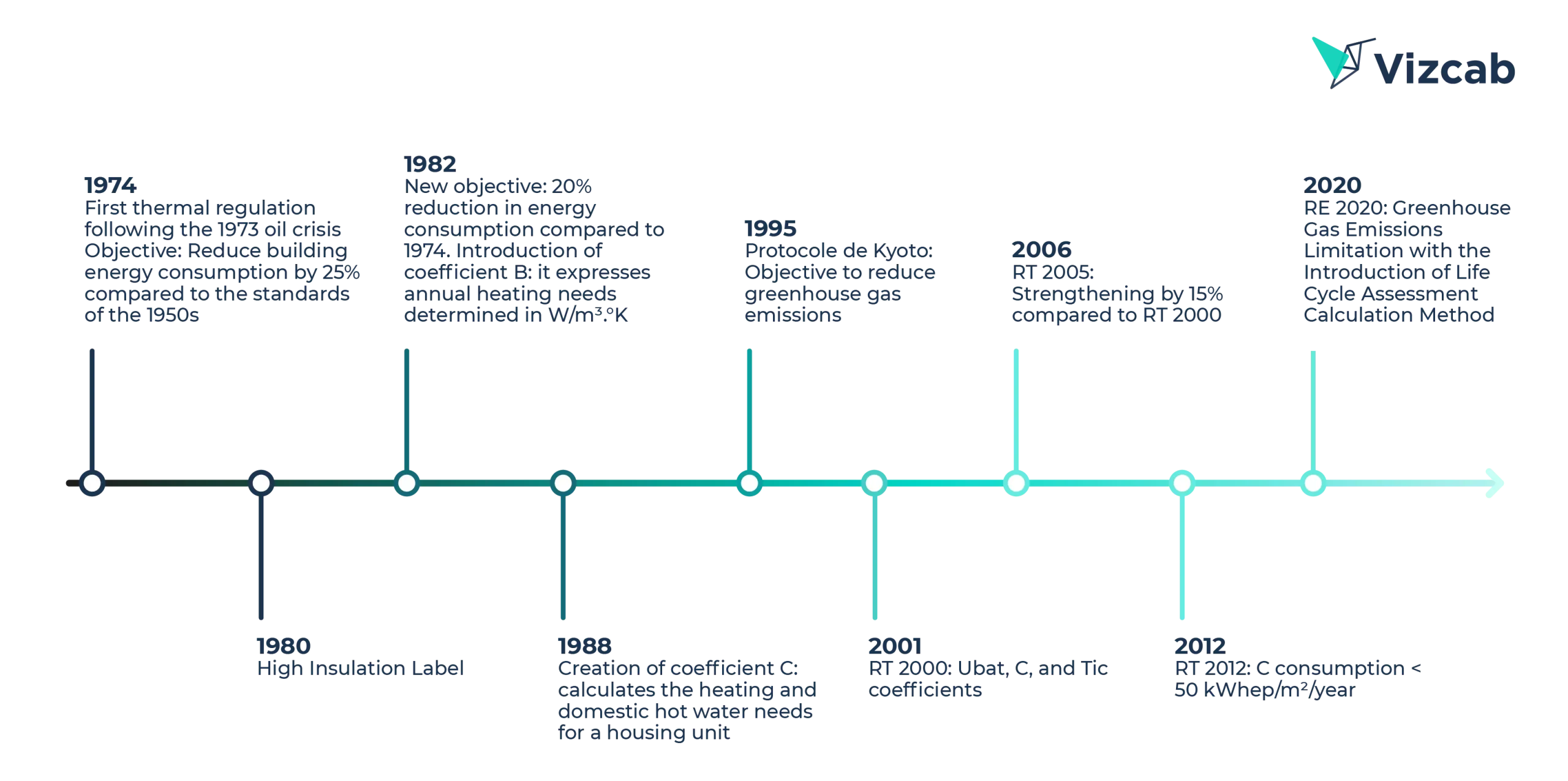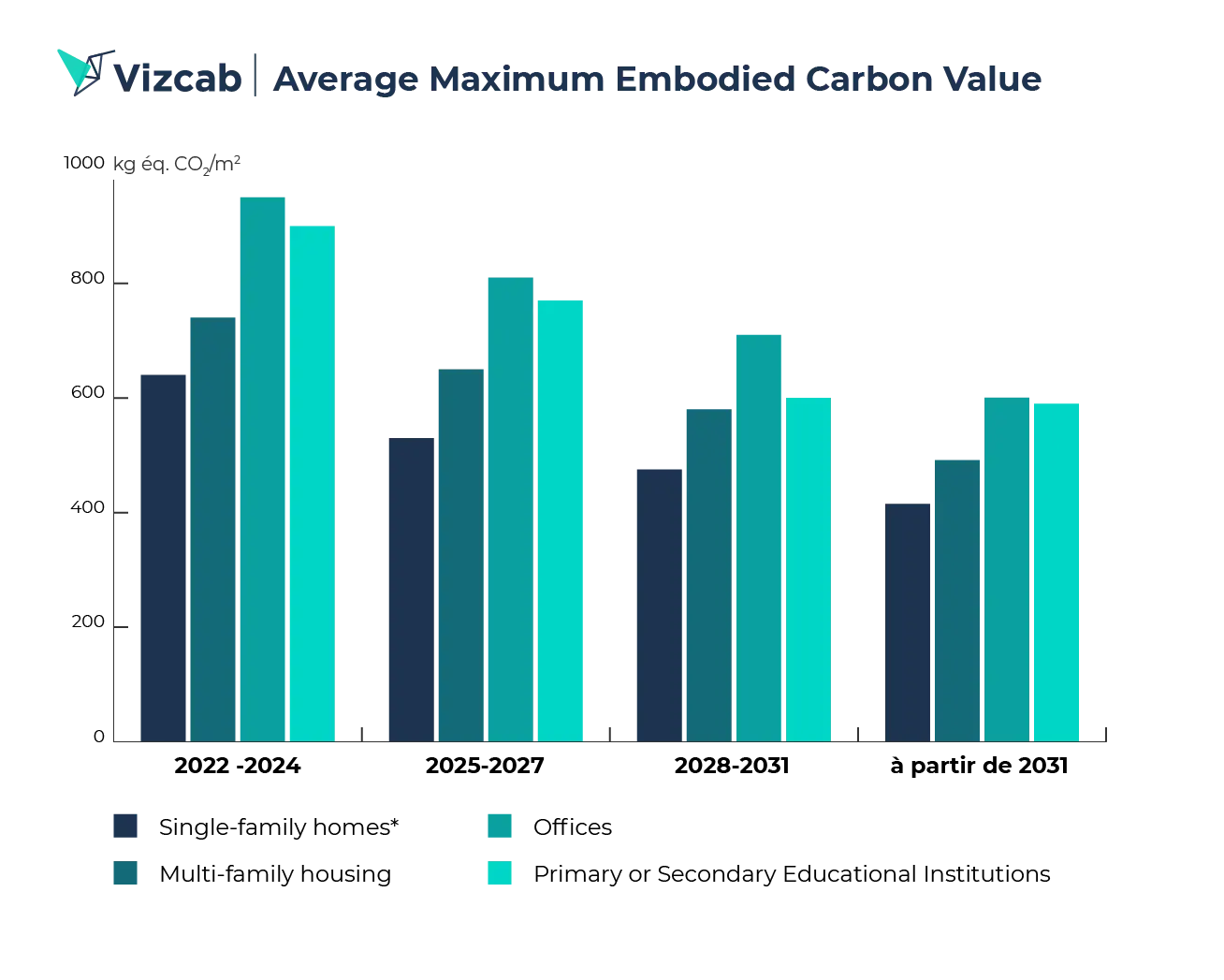
RE2020: key points of the new environmental and thermal regulations
The first thermal regulations dating from 1974 aimed to reduce energy consumption in buildings by 25% compared with the old standards dating from the 1950s, introducing insulation and thermal regulation measures.
Gradually, with the regulations of 1982, 1988, 2000 and 2005, France strengthened its energy efficiency requirements, integrating new criteria such as G, B and C coefficients to measure energy losses and needs, and creating labels to encourage energy-efficient construction.
RT 2012 marked a turning point with more ambitious targets for the use of renewable energies, improved insulation and waterproofing to reduce heat loss. It introduces some of the future indicators of the RE 2020: Bbio (energy requirement for heating), Cep (total energy consumption) and Tic (summer comfort).
In this vein, the RE2020, launched after a phase of E+C- Carbon-Energy experimentation in 2017, aims not only to reduce primary energy consumption, but also to limit GHG emissions over the life cycle of buildings, preparing the building sector for even more sustainable and energy-efficient construction.

RE2020 objectives
- Reduce the impact of new buildings on the climate by taking into account all the building's emissions over its lifecycle, right from the construction stage: requirements relating to GHG emissions from energy consumption encourage the use of energy solutions that are both more efficient and less carbon-intensive, and requirements relating to GHG emissions from building materials and equipment throughout their lifecycle (60 to 90% of the carbon footprint of new buildings comes from the construction and demolition phases, according to the E+C- experiment).
- Continuing to improve the energy performance and lower the energy consumption of new buildings: regulations are evolving to surpass previous standards, emphasizing improved insulation for all heating systems, through the reinforcement of the "bioclimatic need" (Bbio) criterion. RE2020 continues to focus on reducing energy consumption. In addition, stricter criteria are applied to buildings' bioclimatic need (Bbio), aiming for a further reduction in heating requirements (around 30% compared to RT 2012).
- Guaranteeing residents that their homes will be adapted to future climatic conditions: A new summer comfort target has been introduced to ensure that buildings are more resistant to heat waves, which are becoming more frequent and severe with climate change. In the current context of global warming, buildings must adapt to rising temperatures and more regular heatwaves. The RE2020 takes summer comfort into account by adopting a new indicator, the number of Degrees-Hours (DH) of summer discomfort, aimed at minimizing discomfort during periods of high heat and avoiding the systematic use of air conditioning.
Indicators associated with RE 2020
Energy indicators for thermal regulations
Bbio
The Bbio is an indicator that measures a building's energy requirements to maintain thermal comfort without relying on installed energy systems.. It is influenced by architectural design and the quality of the building envelope, including insulation, airtightness and inertia. With the RE2020, this requirement systematically includes cooling: representing a reduction of 20 to 30% compared to RT2012, adjusted according to various factors such as location and surface area.
Bbio underlines the importance of a building's intrinsic energy efficiency, highlighting the efficiency of its structure through good orientation, air permeability and insulation, independently of the energy equipment. This approach promotes sustainable energy efficiency in buildings, with a life expectancy far superior to that of technical equipment.
The RE2020 makes adjustments to the Bbio,integrating cooling requirements, modifying the reference surface and weather data to more accurately reflect climatic evolutions. Bbio thresholds vary by building type and are modulated according to geographical and design criteria, requiring significant improvement in envelope performance through design optimization and better insulation, among other things.
Cep and Cep nr
In the RE2020, the RUE measures the primary energy consumed by a building, covering a wide range of energy-intensive uses. The RUE is expressed in kWhep/m²/year, and is adjusted according to factors such as location and surface area.
CEP,nr (Non-renewable Primary Energy Consumption) focuses solely on non-renewable energy consumption, excluding renewable energies from its calculation. This more restrictive indicator aims to discourage the use of fossil fuels and promote renewable energies.
This represents a 15% to 20% increase on RT 2012 requirements, and has a direct influence on the choice of energy solutions, penalizing certain polluting systems in particular.
CEP and CEP,nr are key RE2020 tools for measuring and limiting energy consumption in buildings, promoting an approach that reduces dependence on fossil fuels while supporting modern comfort and reduced environmental impact. These indicators underline the importance of distinguishing between primary energy (energy source) and final energy (consumable energy).
IC Energy
The Ic Energie evaluates the CO2 emissions of a building's energy consumption over its 50-year lifecycle. For example, for single-family homes, a maximum threshold has been set at 160 kg eq CO2/m² from 2022, while other building types follow progressively lower thresholds. This indicator calculates the impact of greenhouse gas emissions linked to the building's energy use.
Introduced by the RE2020, the Energy Ic encourages the use of energy sources with low CO2 emissions, promoting heat pumps, wood heating or heat networks... This criterion aims to influence energy decisions in favor of more environmentally-friendly solutions, with scaled CO2 emission thresholds to encourage a gradual transition to less carbon-intensive energies.

Carbon indicators for thermal regulations
IC Construction (construction carbon index)
It is used to study the impact of building construction, taking into account all stages of the life cycle over a 50-year period, from the production of raw materials to the end of the building's life, including construction and replacement of materials during renovation. Like the IC Energie, it is calculated in kg eq CO2 / m².
The result is given by the sum of the following two indicators:
- Ic worksite, i.e. the impact of the worksite (consumption of site machinery, excavation and transport of soil, consumption of water and electricity for the living quarters, temporary components).
- Ic components, i.e. the impact of building materials, calculated using the environmental data available in the Inies databasedatabase, for each building product and equipment.
The CI construction thresholds will be lowered over the years, starting with higher limits in 2022 and aiming for a significant reduction by 2031. This reduction is gradual, to give the industry time to develop new technologies that minimize the carbon footprint of materials.


What you need to know
Other informative indicators such as IC Bâtiment, ICded and stockC make their appearance:
- IC Building: This defines the building's dynamic impact on climate change, with 4 key contributors: components, the building site and energy and water consumption.
- IC ded: This defines the impact of default and flat-rate environmental data used in building assessment. Its aim is to encourage manufacturers to publish environmental data sheets (EDS) for their products.
- StockC: This highlights the quantity of kgC of carbon stored in the project due to the use of carbon-storing materials (bio-sourced materials, concrete, etc.).
DH summer comfort indicator
The Degrés-Heures (DH) indicator assesses summer thermal discomfort in a building by calculating the duration and intensity of periods when the indoor temperature exceeds a comfort threshold, defined at 26°C at night and adjusted between 26 and 28°C during the day depending on outdoor conditions.
Two main thresholds are defined: a low threshold at 350 DH, below which the building is considered comfortable, and a high threshold at 1250 DH, indicating unacceptable discomfort. Between these thresholds, a penalty linked to cooling requirements is applied, affecting the building's primary energy consumption and encouraging improved insulation or the adoption of passive solutions to improve summer comfort.
Instead of favoring air conditioning, which increases energy consumption and carbon impact, the RE2020 encourages the use of more economical and environmentally-friendly passive or active solutions to keep DH thresholds within acceptable limits, thus reducing environmental impact and energy costs.
Carbon indicators for thermal regulations
Between the E+C- methodology and the RE 2020, the method for calculating impacts is evolving: while the former is based onstatic LCA, the latter introduces simplified dynamic LCA. Dynamic LCA weightsglobal warming impacts according to the time of emission.
To put it simplysimplified dynamic LCA aims to :

Realistically study the degradation of greenhouse gases in the atmosphere.

To better characterize the notion of climate emergency.

Take into account the uncertainty of end-of-life scenarios.
The environmental study of a building is carried out over a 50-year period. For this same building, a specific type of window is used. This window has an A impact on the environment.
With the E+C- experimental methodology, the calculation method is based on static LCA: a window and the one replacing it 20 years later have the same impact. If each window has a theoretical lifespan of 20 years, it will be renewed 2.5 times over the LCA study period, i.e. 50 years. In our case, the impact of a single window at building level is thus 2.5xA using the static LCA methodology.
With the RE 2020 dynamic methodology, the impact of the window installed at the start of the project and the impact of the one replacing it after 20 years is no longer the same! Window renewal is taken into account, but the impact of each window is weighted over time. The greenhouse gas emitted today weighs more heavily in the final calculation than that emitted in 20 years' time.
👉 Finally, the dynamic LCA used to calculate the impacts of RE 2020 incorporates the notion of climate urgency by weighting impacts according to the time of their emission, which is not the case with static LCA.

Application timetable and buildings concerned
- From January 1ᵉʳ 2022, the new environmental regulations are introduced for single-family homes and multi-family housing.
- Then, in July 2022, it was the turn of offices and primary and secondary education buildings.
- In January 2024, for all commercial buildings.
- In 2025 for the following buildings: childcare facilities, media libraries, hotels, restaurants, university buildings and shops.
- Finally, discussions are still underway for buildings used by the health sector, industry and craft trades, gymnasiums and changing rooms, and airport terminals(Source: DHUP at the March 5 consultation on retail and university uses).
Labels associated with RE 2020
An RE 2020 label will also be introduced to enhance the value of projects in line with the new environmental and thermal regulations, following the example of the E+C- label in place for virtuous projects that went beyond the requirements of RT 2012.
The development of a common reference framework should culminate in a public reference framework by the end of 2024.
A regulatory context in the making
RE 2020 is part of a regulatory context linked to a general awareness of sustainable development. At European level, the CSRD (Corporate Sustainability Reporting Directive) and the Green Taxonomy came into force on January 1, 2024. Their aim is to enhance corporate transparency and steer investments towards more sustainable activities.
The CSRD establishes standards for extra-financial reporting, requiring companies to disclose their environmental, social and governance (ESG) impacts and practices. At the same time, the Green Taxonomy creates a classification system to identify economic activities considered sustainable, thus guiding investments towards a green economy.
Both initiatives share the common goal of promoting sustainable development.
In France, the follow-up to RE 2020 is being prepared: CAP 2030. Discussions on a methodology for new-build and renovation are underway. Even if there is no question of thermal and energy regulations for CAP 2030 at the present time, these discussions will have an impact on the construction industry in the years to come. Stay tuned...
Make the transition to generalized LCA a success
Benefit from the expertise of Vizcab and its team of carbon engineers
Stay up to date with our LCA blog
A compendium of resources and strategies on building life cycle assessment for the construction industry, including studies, articles and best practices on LCA and low-carbon construction.
Upgrade your skills with our knowledge base
Benefit from the expertise of our team of sustainable building engineers. Find out more about our tools, building LCA and more on our Vizcab knowledge base.
Discover our LCA training courses for all levels
- Raising awareness of new environmental regulations
- Getting to grips with our RE2020 tools
- Training courses tailored to your level of knowledge
- Qualiopi accredited training courses registered with the CPF.
